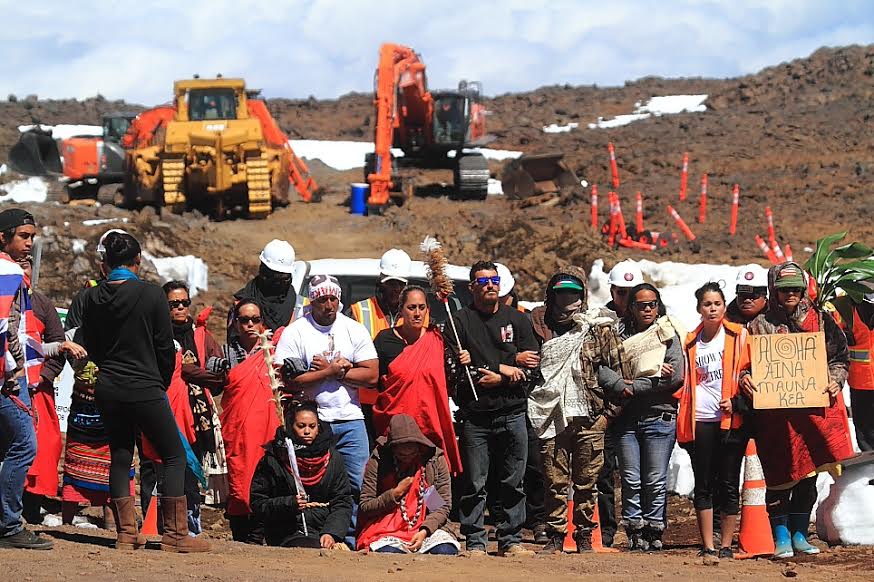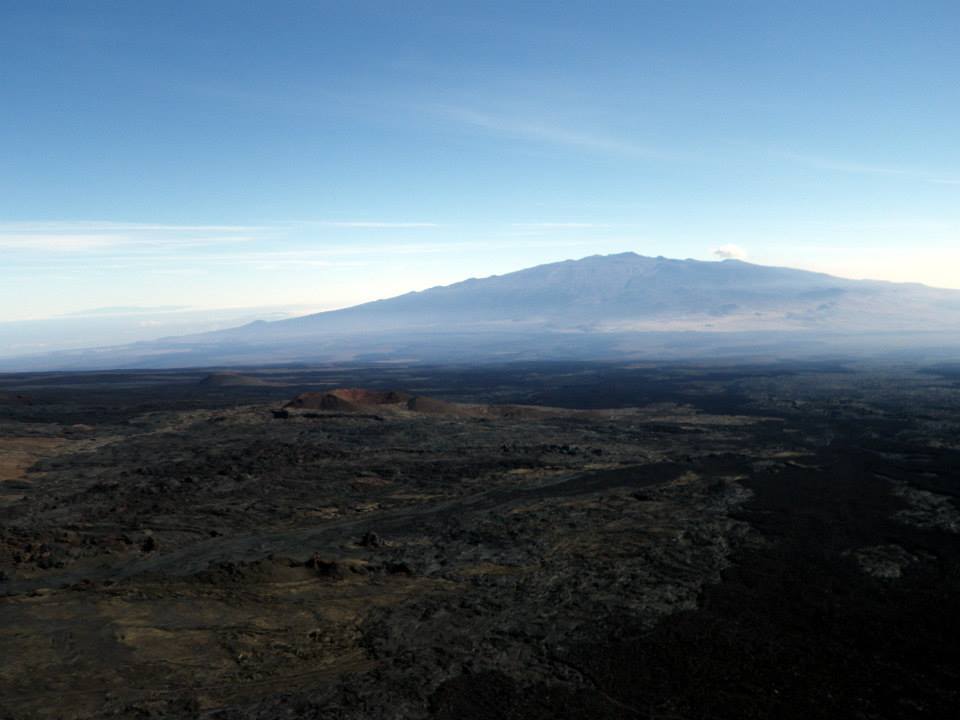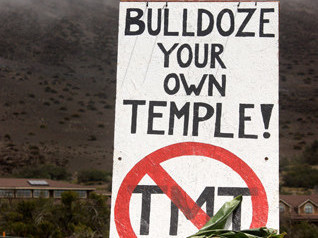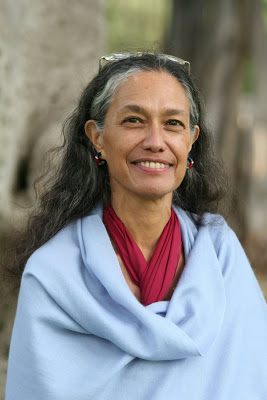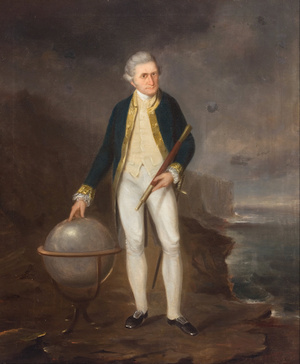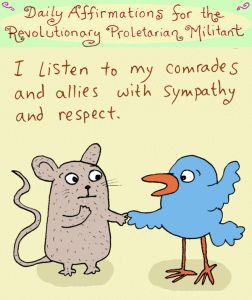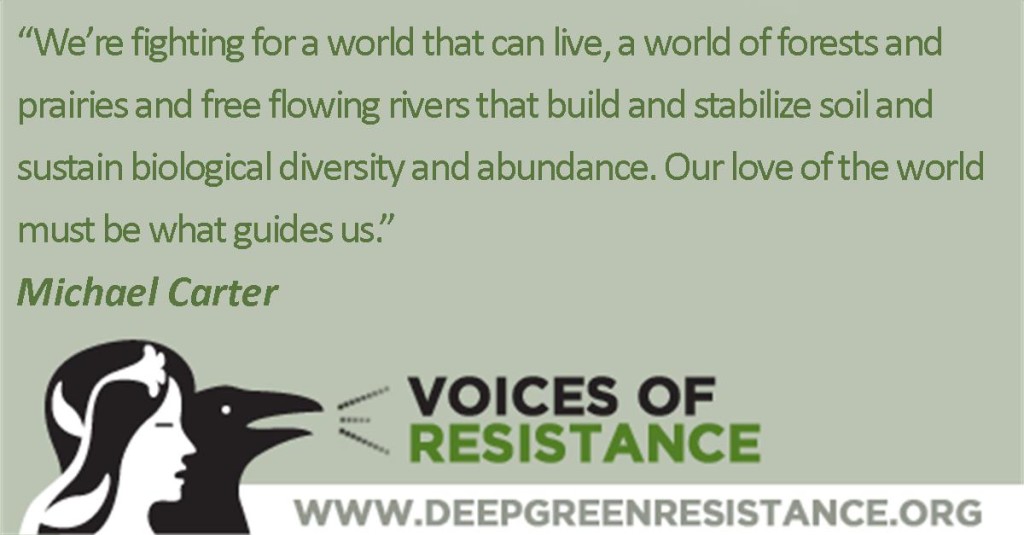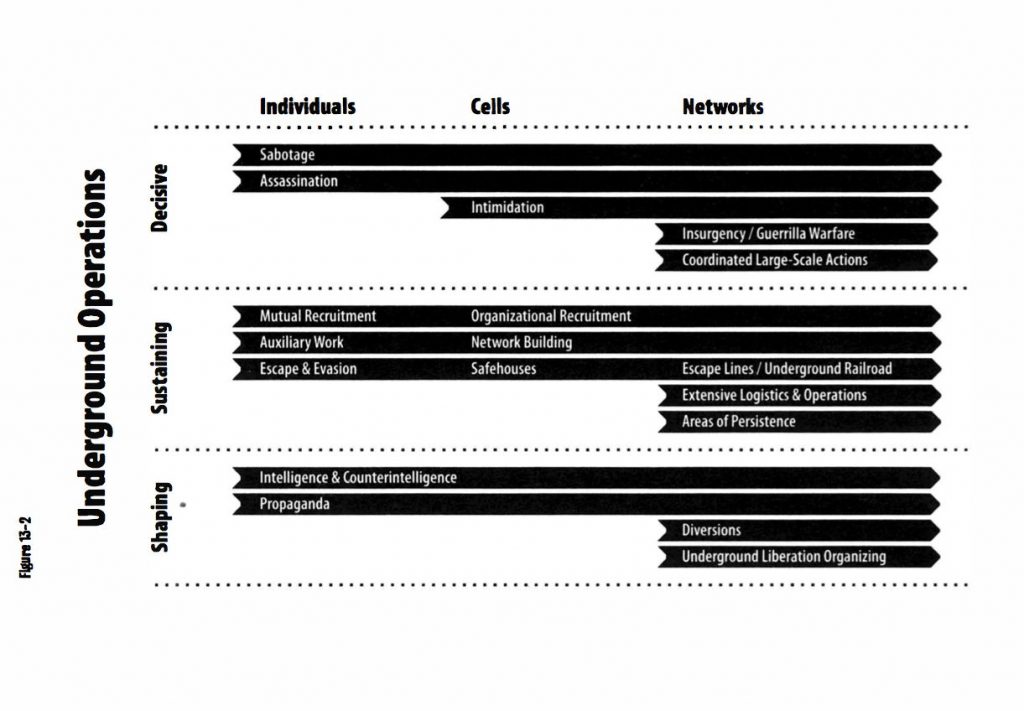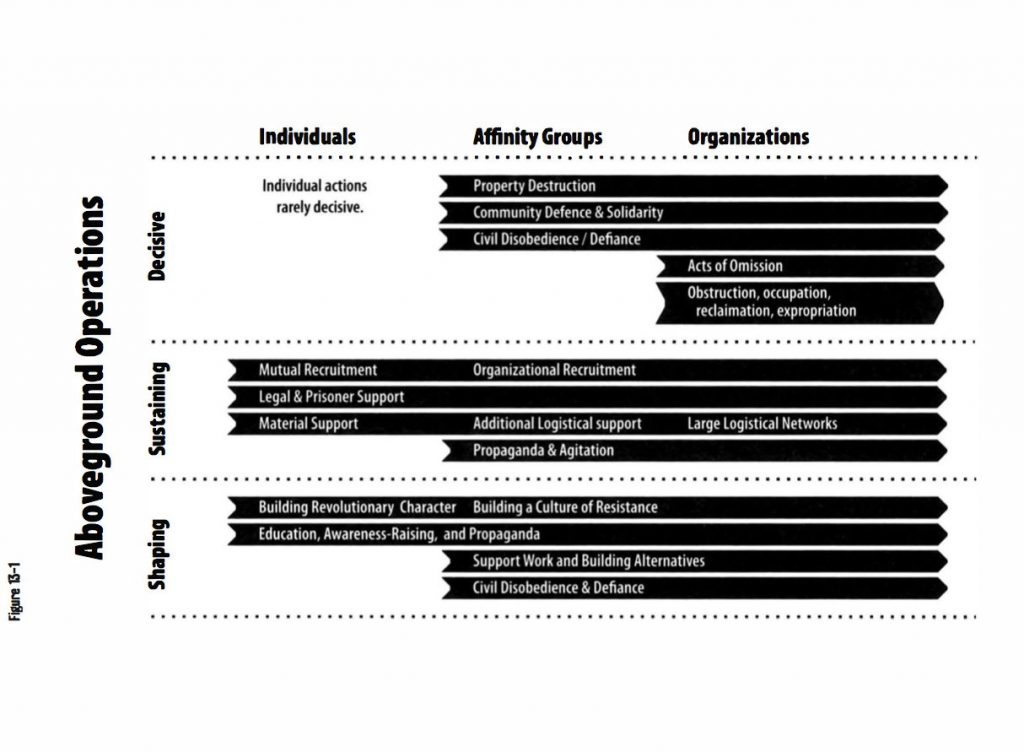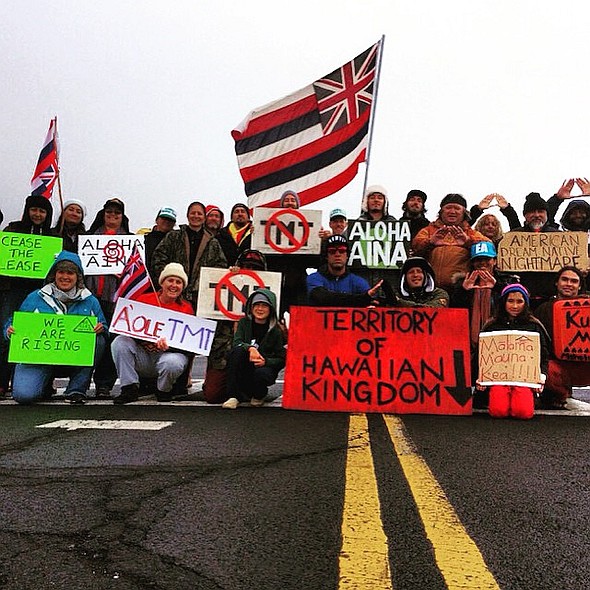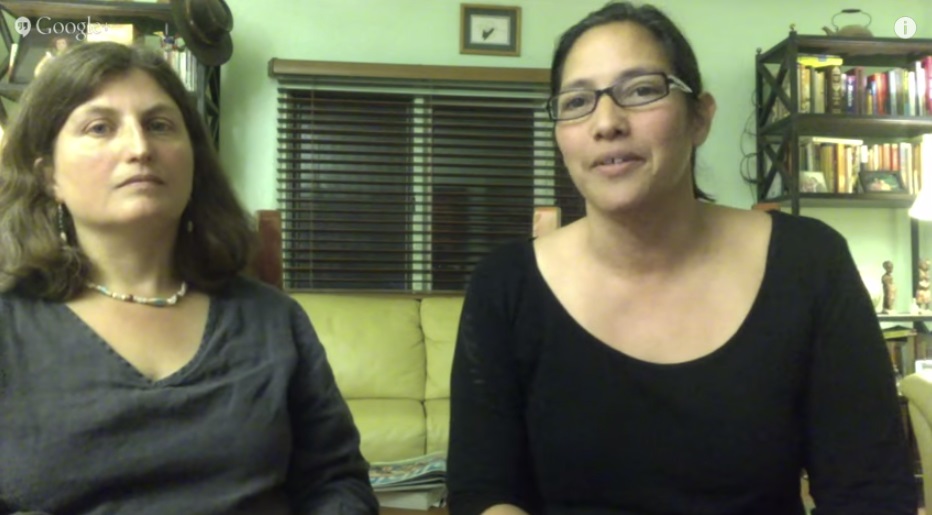
On Sacred Biology: Interview with Michelle Peixinho and Mary Lou Singleton
Editor’s Note: This video was streamed live on May 14, 2015, by TRTV Show Real Talk. Deep Green Resistance volunteers transcribed the dialogue, published here.
Mark: Hello, hello, and good evening and welcome to transition radio live from the land of enchantment: Silver City, New Mexico. My name is Mark Angelo Cummings.
Lynna: And I’m Lynna Arielle Lopez, and I’ll be your hostess.
Mark: Yes, and I am your host, hostess. Gender, what is gender?
Lynna: Male? Female?
Mark: We’re human beings. The way I always like to say, we’re spirits having a human experience.
Lynna: That’s right.
Mark: Some of us have taken this human experience a little too far. It’s all about growing and learning. And talking about learning and growing, you get to know your true friends are all about times of situations when you no longer sing the same tune that you used to sing before, and then people freak out. They attack you, they unfriend you. They go as far as to take away your livelihood.
Lynna: Sabotage maybe.
Mark: Yes, sabotage. I wanted to share a little email that we got from somebody who was giving us a heads up on who actually contacted the sponsors. The email goes:
Just a heads up Mark, this was posted in FTM Wolf Pack. Josh Ortiz—good friend apparently….
Lynna: Fellow FTM
Mark: Yes, which I thought.
“What can we do to stop him”, he quotes. “That’s what I’ve got to know. I work closely with Spunk Lube”—one of our sponsors—“I contacted them yesterday morning and advised them of his agenda. They pulled their sponsorship immediately. Same with the Breast Form Store. I contacted them also and they pulled their sponsorship” He stated: “he will be teaming up with hardcore right-wing conservatives. My fear with that is this: the 1% has 99% of the funds. The funds they will gladly pay to someone like his dumb ass”—he’s referring to me—“and their agenda. What can we do?” Well it seems to me that they’re actually threatening. God knows we’ve already got some threats on Gender Trender “we know where you live.” This is bizarre. Truly Bizarre.
Lynna: All because we want to say the truth.
Mark: Because we want to expose that this whole transgender—gender dysphoria—is all a lie. We’re going to have shows about that, explaining what we mean by “it’s all a lie”, and go into greater details. Really put some light on this subject.
Lynna: Transition Radio TV is more like transitioning from that thought to a new type of thought.
Mark: Like our intro says: a new beginning, a new way of thinking, a new way of being. This whole concept of black and white, people have to realize that there are so many shades of grey.
Lynna: So thanks to Josh we don’t have a sponsor for our show anymore. Thank you Josh. We’re going to be looking for new mainstream sponsors to sponsor our program.
Mark: Individuals that believe in what we’re doing are always telling me they didn’t help us because this has been our focus. We plan to take this to the next level. We plan to educate: do seminars, talk in schools, and try to prevent this black and white you’re either a boy or a girl. We need to stop this mentality and especially stop these drugs that are being given to our kids. The blockers, and hormones and 14 year olds having their breasts cut off. I look back on what I’ve done. I want to have a show especially on this, and really pour my heart out in what’s created these changes in me.
Tonight we have two amazing ladies, Michelle Peixinho and Mary Lou Singleton. Michelle San Buenaventura Peixinho is a Filipino-American originally from Manilla and Honolulu. She has been living in Rio Arriba with her family since 2000.
Lynna: Michelle has over 20 years non-profit experience beginning in 1992 with the environmental, and environmental justice movement. She has worked as a community leader, organizer, program manager, development director and executive director. Since moving to northern New Mexico she was appointed by the governor to serve on the New Mexico Women’s Health Council from 2005-2009. Michelle served as a Midwives of Color section chair for the Midwives Alliance of North America from 2008-2010.
Mark: Michelle holds a Bachelor degree and is a certified professional midwife and a licensed midwife in the state of New Mexico.
Mary Lou Singleton was raised in an Irish Catholic working class family in a dying steel town during the Reagan recession. She has been a lifelong advocate for the rights of females.
Lynna: After graduating from Grinnell College she moved to Albuquerque New Mexico to study midwifery and herbalism, and has lived in New Mexico since. She has served on the Boards of Directors of the Midwives Alliance of North America and the National Association of Certified Professional Midwives, and worked for over 15 years as a busy home-birth attendant.
Mark: Welcome to the show, the lovely Mary Lou and Michelle.
Mary Lou & Michelle: Thank you. Thanks for having us on.
Mark: It’s a pleasure, it’s a pleasure.
We were watching some videos earlier today to get a little glimpse of the lives of midwives and what they actually do, since it’s pretty much gone to the wayside. Or am I wrong, is it something that’s still very much used nowadays? Or is the grim hospital what waits for pregnant women?
Michelle: Only about 1% of the babies in this country are born at home. Compare that to a country like the Philippines—or another developing country—where almost 60% of the babies are born outside of the hospital. So that’s how far we’ve come in our use of the hospital.
Lynna: Is that in a very short amount of time? Within the last 30-40 years?
Mary Lou: Before World War II about 90% of births occurred outside of the hospital, and since the 50’s it’s turned to 99% of births happening in the hospital. It very much paralleled the industrialization in the rest of our culture, turning everything into a mechanized scientific process rather than a natural process.
Mark: My great grandmother in Cuba was a Midwife…
Mary Lou: Great, you’ve got it in your blood!
Mark: It’s pretty sad though that society, and the human race, puts so much trust in the medical system. They don’t even realize that the medical system is not there to help them. That includes the process of birthing.
Michelle: It is a market driven system. Bottom line. When you have a market driven system those are going to be the priorities. Right now our maternal health system is such that we have natural assets right there in the room that we are not even utilizing. In fact we are negating, and making it impossible to utilize them. That is what is embodied in the woman herself, in her body. The hormones and the biological system that is available to us if we wanted to use it, and the natural world; the plant life, and the animal life, the spirit life, whatever it is that we have access to. Those are things that are extremely powerful, and at the heart of midwifery and child birthing that is not presently used at all in maternal health in hospitals.
Lynna: In a hospital setting when the woman is pregnant, the hospital and the doctors all encourage them to just go with whatever is available in the hospital. They install a fear of complications and issues that may arise. That’s one of the first things I hear when people say “Oh you’re going to have a baby at home with a midwife. Don’t you know that you could run into all kinds of complications?” What do you say about that?
Mary Lou: Our species has been very successful at reproducing. We’ve taken over the entire planet. Birth works really well. If it didn’t work so well we wouldn’t have evolved to the point where we have hospitals. I think for a healthy low-risk woman, birth 90% of the time will happen just fine attended by conscious careful loving midwives who can, like Michelle said, channel that power that is inside the body that comes through our biology and life. Everything in the hospital is designed to suppress that power and to turn off maternal instinct—to turn the woman into the patient.
Michelle: Not just only to suppress but to appropriate. So for example: we’re not even allowing a woman to access her own pituitary process to produce the hormones that stimulate the uterus and create labor. Instead what we’re doing is using a synthetic form of it called Pitocin, which was the first synthesized human hormone ever: Oxytocin. So Pitocin is the synthetic form. So not only are we just not using it, we’re actually appropriating it. Medicine is appropriating it, synthesizing it, putting its own name on it, then disallowing us to utilize our own endocrine system—what our own pituitary gland could produce—and then pumping women full of this synthetic hormone instead.
Mary Lou: Close to 100% of women giving birth in a hospital will see that synthetic hormone either during delivery—most of them during delivery—and definitely after delivery if they haven’t received it before.
Mark: That seems to be the wave of the future with everything. Everything is synthetic and then our own bodies stop producing certain things and we become like robots. Back in the day before there were hospitals, and even before there were midwives, women would have the babies on their own. It was just a very natural thing. You pushed—you know they were all working on the field then—until there she is or there he is. We’ve lost our way; we’ve become so dumbed down and so mechanized. It’s like we’re robots. It’s really sad that people can’t think for themselves. They don’t realize that they could tap into their own healing ability. And tap into mother earth. She provides everything we need.
Mary Lou: Absolutely. What I’ve witnessed in hospital birth is that no other mammalian species would put up with being treated that way during birth. A cat would rip your face off if you were treating her that way when she was giving birth.
Mark: Exactly.
Mary Lou: They are very much destroying our instincts, destroying our innate power.
Mark: So what got you interested in midwifery? What was the ah-hah! moment to enter that profession?
Michelle: We all have different very unique stories. I didn’t even know anything about midwifery when I was first pregnant. I was homeless, and was doing my prenatal care at San Francisco General Hospital. I was very intimidated by the authoritarian nature of the hospital. I felt very child-like when I went in there. This was before I had recovered my childhood incest memories, but for some reason I was very repelled by the idea of trying to get this baby out of my body in the midst of these authoritarian figures that really seemed to trigger me. I didn’t understand it all at the time, but I was blessed somehow.
The creator guided me—at 7 months pregnant—to friends who told me “you know you can have your baby at home with the midwife, you don’t have to have your baby that way.” I didn’t know that! I hit the road. We went up to Oregon where midwives are much more accessible than in the Bay area where I was at the time. I shacked up at a friend’s house at a mobile home park, space number 34. That’s where I pushed my baby out. That changed the course of not only my parenting, my relationship with my child, and my own body sovereignty, but also my trust in myself to make health care choices for my children, to trust nature, and the power of nature. So I was able to then use natural remedies for my children. I might not have been able to develop that relationship and that trust otherwise. It was through my own body first. Being a 19 year incest survivor, really it was the first time that my body did me right. I was so grateful. It was the first time that I said “oh,wow, this shit works”. It felt powerful. So that’s why I became a midwife, because I really realized at that moment how important that was: the power that I experienced.
Mark: And what about you Mary Lou?
Mary Lou: Me? I sort of came out of the womb this way. Just really angry about the patriarchy, and justice. Ever since I was little I wanted to help women have babies. I remember being very small, in kindergarten or first grade. I was told that means you want to be an obstetrician. So I was pretty good at school, I went through grade school and high-school thinking I was going to be a doctor. Went to college, and in my sophomore year took a class called Sex and Culture and learned about midwifery in a contemporary context. I didn’t even know it existed before that. It was the classic light bulb, this is what I’ve always wanted to do, I just didn’t know there was name for it.
So I immediately dropped organic chemistry—which I hated—and I started working towards being a midwife. I studied with a birth center. Before I had children I was in college. I studied with a group of nurse midwifes and saw my first births which was amazing. The next summer I lived on a farm with one of the founders of a well-known midwife organization. Then I moved to New Mexico to be a midwife.
Like Michelle, I had my first baby at home. I’m also, like so many women, a sexual abuse survivor. I had been at war with my body since childhood. Very much hated my body, always wore big clothes, bound my breasts, didn’t want any male sexual attention, or wanted too much, acting out hyper-sexually. Like Michelle, when I gave birth, it healed me. I realized my body rocks. I just made a human being and pushed it out. Now I’m feeding it with my breast. I’m a freaking super hero. It made me feel powerful and intact; and not in a way of having power over someone else, but being in my power. My sovereign self. And I also wanted to share that with women. I would love to live in a culture where the majority of mothers feel that way.
Michelle: Or people. Everybody.
Mary Lou: People. Yes.
Mark: We want to go ahead and share a little clip of a video that we found on midwifery. Let me go ahead and share this video here.
(Video clip of Midwives Season 1 Episode 1 S01ED1 Delivering Under Pressure)
Midwife: Little pushes, little pushes.
(baby being born)
Narrator: When we’re at our most vulnerable, we all need someone who isn’t afraid. Midwives are responsible for bring our children safely into the world.
Midwife: It’s a very, very intimate relationship with something you’ve never met before in your life.
Narrator: But now they’re facing the highest birth rates in 40 years. Parents are more demanding, and pregnancies more complicated.
Midwife: When you see a baby come out like he did you just think “oh no.”
Narrator: This is what it’s really like to be a midwife in Britain today.
Mark: In Britain it seems like they’re having a lot of babies so they’re in need of midwifery.
Mary Lou: In Britain midwives attend the majority of women. Most of those are in the hospital setting. They have a very different system of maternity care. They don’t have a capitalist health care system there. They make decisions based on what produces better health outcomes for the population, not what makes the most money for profit health care companies.
Michelle: Yes. Countries like that, like in Ontario also is another example where there’s really strong collaborative care between hospitals and homes so that you might even have a continuity of care where the same provider attends you either way if you have to transport or you can choose which location.
Here, everything is very segregated. So the hospital is its own system. Birth centers are even, a lot of times, their own systems, or completely co-opted by hospitals and run by hospitals in which they’re not free standing autonomous birth centers. They’re bound by hospital policies. And then there are home birth midwives who operate almost completely separately. So what happens in England, Ontario, and other places, is a much more integrated system.
Mary Lou: Right. We know how our medical system works. There’s money in pathology—and the manufacturing of pathology—and birth is in some sense just a microcosm of that. But it’s also the right of passage into a technocratic society that wants to sell you a lot of health care, and other products.
Mark: Yes, and push all the drugs, and create all these diseases and labels so that they continue to push you through the system. I know it all too well. I’m an occupational therapist, worked in the system for over 18 years, and couldn’t stand it anymore.
Michelle: Yes, based on pathology.
Mark: I’m a spiritual person. I believe that the body is capable of healing itself through nutrition, through proper meditation, though visualization, and they offer none of that. Everything is based on a Band-Aid approach and pills that give you more problems.
You were speaking earlier about you bound—Michelle, or Mary Lou actually was the one who said that you bound—and that you hated your body. I wanted to bring this up because that seems to be a lot of the scenario with female to male transgender or transsexuals. They think that it’s such a horrific thing to go through the stage of hating your body. I think it’s a very normal thing for people to go through dysphoria at one point or another.
The abnormality is when you have to do the terrible thing that I did. I ripped my breasts out, and I ripped out all of my female reproductive organs in quest of what to me now seems very delusional. I’m forgiving myself for what I did, but it’s something that is bizarre. Totally bizarre. And that’s why the passion right now to move forward with this quest. Can you give me a little more in-depth, or share your experience and what you think the scenario is with these female to male transgenders.
Mary Lou: One of the reasons I feel passionately opposed to the marketing of gender dysphoria is from my own experience and how I think, if I’d been born 20 years later, I would have been convinced by this relentless marketing on the left—and on the right now too—that hating your body is actually an identity. I didn’t like my body, I had an eating disorder at one point, I tried to starve away my secondary sex characteristics. I was happy when my period went away, I was happy when my breasts went away. A lot of that was because of childhood sexual abuse and unwanted sexual attention.
I think even people who aren’t physically sexually abused— all girls in this culture—have all of this abusive attention coming at them. We live in a rape culture and every female is a victim of that. Every female is a survivor of that.
A lot of times I just didn’t want it. I shaved my head. I would wear the tightest sports bra I could find, I would wear the biggest, baggiest, clothes I could find. At one point, I remember walking around in college and thinking “everything I own I bought in the men’s or boy’s department. I am a female transvestite”.
At the time there wasn’t this huge trans phenomenon. This has happened really quickly in our culture. I’m not an old woman by any means. I think body dysphoria is the norm for females, and also for males now. I think that capitalism thrives on making us hate ourselves and think that we have to buy something outside of ourselves to feel good. To feel great.
Mark: Definitely. When you talk about being sexually molested, I was sexually molested at 8 years old by a so-called friend of the family. It was almost like a grandparent for me. I think a lot of FTMs and probably a lot of MTFs experience this as well, it’s a big psychological issue. And that’s what we’re trying to bring out that GD is just like a cough is to a cold. Gender Dysphoria is not the main psychological problem. There are a lot deeper problems. Narcissism, bi-polar disorder, anxiety, schizophrenia, the list is mile long. The therapists are missing the point. They’re handing these papers out like they’re handing out candy, for people to take hormones, to alter their bodies. Something needs to be done, this should be made against the law. These doctors should be held accountable. These therapists should be held accountable.
Mary Lou: We have no idea of the health outcomes that we’re going to be seeing from this even in the next couple of decades. I am a nurse practitioner. I know, talking to other practitioners, people are seeing lots of elevated lipids in people taking these hormones in adulthood. We’re seeing cardiac anomalies, and other health problems from the hormones. Frankly, I don’t even like giving out birth control pills because of the risk. I don’t like giving artificial hormones to people. I understand that’s everybody’s choice, but I feel like it’s dangerous to do that and people need to know the risks. This is a big untested experiment that’s being pushed on our children.
Mark: Definitely.
Lynna: Can you tell us about the latest accusations that you were assigning gender at birth?
Michelle: Mary Lou introduced me to radical feminism only a few months ago. So a lot of this is new to me, but my thinking, my thoughts as a person, as a midwife, is not new. And for years I’ve been involved in reproductive justice, and this is where I was first confronted by some trans midwives, who were saying that my language was incorrect and that I needed to be referring to this process of assigning gender at birth. This is the first time I heard this. I maintained that women are giving birth, and we have biological reality that exists, before even a baby is pushed out of the womb. I was black listed in those circles as a bigoted closed-minded person.
We absolutely have nothing to do with assigning gender whatsoever. That’s something society does. Gender is a socially constructed thing. It’s not an immutable fact. It’s not something that’s innately part of a human being. So you have a child that’s born, we look at that baby, and you know, in our practice, and our training, we don’t even actually name the sex of that baby. Even though we look, we can see what’s going on there, we don’t tell the mother the sex of her baby. We let her do that herself. At best, if she asks us, we’ll lift a leg. Maybe if she asks us to tell her what the sex is, and she just can’t see the baby at that moment, we might whisper it to her. Very rarely will any of us home-birth midwives really be the person to disclose that information to the family. And the other thing is that we’re looking there at the baby, when the baby emerges, and we’re noticing based on the fact that we are a class of beings that have male and female, that is how we are biologically determined.
Mary Lou: This is science.
Michelle: It’s a fact.
Mary Lou: It’s not social science.
Michelle: So females have ovum, and males have sperm. And we know that there are many variances, just like there are variances in chromosomes with Down syndrome babies. There are many variances in the human body. So, many intersex people are born yes, but this is something completely different. This is not the same as trans. So, when the trans people are always wanting to confront the fact that somehow we have determined, as the birth attendants that receive this baby, what gender roles this person is supposed to adhere to. That’s not possible. It is not our determination whatsoever what gender role a person is going to subscribe to. And it doesn’t matter to me what gender role somebody chooses. If they want one, if they don’t want one. Some people identify heavily with gender roles. That’s fine. And it doesn’t matter to me if it matches your biology or not. Those things are all social. We can do what we want with that as a society. That’s a beautiful thing.
But what we’re talking about is the biological reality of a human being in a dimorphic species of male and female. And all we’re doing is observing: what is presenting on this body? And when that mother is ready to receive that information, most of the time, she process that information herself.
Mary Lou: I’ve been at so many births where the 45 minutes goes by before the family even thinks to look because they’re just so excited that the person is here, the baby is here. And the sex of the baby doesn’t even matter until they sort of come back out of the, like you said, that spiritual awe of the experience. But to say that we’re assigning sex or gender is no different than saying that we’re assigning human to the baby. Or that we’re assigning the baby’s species. These are biological facts and observations. When we do a newborn exam we always test to see if the baby’s palette is intact. We’re not assigning the baby with an intact palette. We’re observing.
Michelle: Either the baby has one, or the baby doesn’t have one. We’re doing an assessment. We do a new born exam and we’re looking at what is the characteristic of the baby. Have the testicles descended. These are all biological realities.
Mary Lou: Are there ten fingers, are there ten toes. We’re not assigning—I’ve assigned you two hands—you know? And even beyond that, midwives have been arguing for a long time against pre-natal sex determination, and that we don’t believe ultra sound should be used gratuitously. We feel like that technology is unnecessary. Midwives have been advocating not finding out the sex particularly because we don’t want families assigning gender.
Michelle: That knowledge. The knowledge of knowing what the biological sex is of the baby you’re carrying can only be used for you to assign gender to that child. The only reason parents want to know so bad, is because they want to know how to decorate the room. They want to know what color clothes to buy. They want to know what name to give the child. They want to assign gender to that baby. That’s the only reason to do an ultra sound, because nothing else changes in what the mother’s going to eat, how the mother’s going to take care of herself, how the mother’s going to push the baby out. And when that baby is born, that baby could care less when they look up at that person who gave birth to them, the gender identity of that person. That person is their mother. That person bore them in their body, and created them of their flesh, and pushed them out into this world and they’re still one being. Gender identity is not a factor in that. That is a purely biological process.
In fact, in birth, if you were to remain in an intellectual space of identity as opposed to your biological reality, you would actually hinder your birth quite a bit. Because you would stay in a thoughtful place of the forebrain as opposed to the place you want to get to in birth where it is not intellectual. Totally primal. The oldest part of your brain that you will use.
Mary Lou: We give birth with our biology, not our identity.
Michelle: Not our gender.
Mark: Can you talk a little more about the realities of biological sex, in your opinion?
Mary Lou: I don’t think it’s opinion. I think these are scientific facts that we are a sexually dimorphic species. Like all species that reproduce sexually with a male and female, we have two sexes. One that produces sperm, and one that produces eggs, because we’re mammals, the females of our species gestate our children inside of our bodies and then feed them with our breasts when they come out. I don’t think that’s a matter of opinion, I think any biology text book would state that as fact, and to anyone who can actually step out of the postmodern insane rhetoric and just look at the world.
Michelle: It’s a beautiful thing actually. When you’re carrying a female fetus, you are carrying all of her ovum. So in that moment you have three generations within your one body. That’s the reality, the biological reality, what a woman carries. And that is a huge biological difference between a man and a woman. Because a man cannot do that. There is something about that experience, or even the potential for that experience. It’s very powerful, that reality. That’s what makes the concept of assigning gender false. When these biological miracles are happening in utero, there’s no barrier between that mother and that baby, or the family and that baby, no difference between when it’s inside the uterus and when it’s outside the uterus. So, it’s the same being, it’s the same biological being.
Mark: And what’s happening with the transgender community, especially with the MTFs is that they are totally just negating all these biological things. And they’re totally just, to me, becoming insane.
Lynna: Claiming womanhood when they have no right do to so.
Michelle: The problem in midwifery that I’ve found actually, is not the trans women, but the trans men who still have their uteruses, and are accessing reproductive health services or midwifery services, but claiming to do so as men. This is where I had, in reproductive justice, put out a beautiful sticker that said “midwifery is a woman’s tradition” and I was confronted about that because it was exclusionary. And I consider midwifery to be a woman’s tradition. Midwife literally in Old English means “with woman”. It’s women helping and serving women. It’s often times the aunt, or the sister, or whoever is around that has been to the most births. Often times it’s very much a woman’s tradition.
But we have been confronted at one time. And now our professional midwifery organizations are actually changing the language of their core competency documents to refer to the pregnant individual, or the pregnant person, as if female biology wasn’t at the core of what was happening in this process.
I personally have in my life many trans friends, exes, and just dear ones that I love. My son has a best friend who’s transitioned. We all have love towards their struggling with this on one level or another, because it has become so common, so prevalent. And yet to sit there and be confronted by some of these peers to say that I am supposed to remove the word mother, or woman, from my rhetoric around pregnancy and child birth, while people who are born in female bodies, who are female bodied people, if you identify as a man, you live as a man, you present as a man, wonderful, but you’re not giving birth with your gender identity. You’re giving birth with your body, your biology. That trans man, is using something that he acquired when he was a female, when he lived as a female, when he was born as a female, however that rhetoric is supposed to be said. He still has it, and he is using it, but he is not naming the source of that act and power. It’s possible for him to give birth because that female body, that’s what’s giving birth. That biological miracle. Right now we’re dealing with midwifery organizations actually changing their language in their documents as if to say that it is possible to change your sex, when it is not possible to change your sex.
Mark: You’re right, it isn’t. It’s really sad that this community has gone to the point of madness. They want to re-write all the rules. They want to tell people what they can and cannot say. And actually that’s what started really pissing me off. I had Cathy Brennan as one of my guests last year, and they all attacked me. Cathy Brennan has a right to voice her opinion. No one is going to stop me from having who I want on my show. To me, there are so many deep mental issues with some of these individuals.
Mary Lou: We were discussing that earlier, have we covered that?
Michelle: It seems like we have talked about that a lot, but… with that question you really are, you talk about the power in the female and the power of nature. You talk about that too in one of these questions. We mentioned it a little bit in the beginning. That is the greatest asset in childbirth. One of the things that I take issue with is that as midwives we’re trained to manage and attend women who are having a normal healthy human pregnancy and birth. We’re trained to see when things fall out of the range of normal, and then how to use natural assets to bring things back into balance. Maybe some herbs, or some lifestyle adjustments, stress management, counselling, nutrition, many many many tools that we use. Because we want the woman to try to stay in this range of healthy and normal. And what is striking me right now, is that instead of talking about how as midwives are we supposed to be providing healthy normal human development—midwifery care—to a person who has now been taking hormones for many years or…
Mary Lou: Cut their breasts off….
Michelle: There’s such a huge range of ways that a person could present to us at this point, but we’re not educated in those things, and I don’t perceive those things to be normal, healthy, development. So it’s really outside of the scope of our practice. I just bring that up because the differences in sexes and the differences in the biology is really… I don’t know what I’m trying to say. I lost my train of thought.
Mary Lou: Can I?
Michelle: Yes please, because I know that you know what I’m trying to say.
Mary Lou: I want to say that patriarchal oppression, absolutely exists, and by patriarchy I am using what Bell Hooks phrased as the white supremacist, capitalist, patriarchy exists to control female reproduction. If power is passed through men, women’s sexuality and reproduction has to be controlled. And the basis of our oppression is from our biology. Our power is in our biology absolutely, and the patriarchy does everything it can to control and own that power and try to keep women from having sovereignty over that power. One of the most frightening aspects of this erasure of the reality of biological sex, and the complication of gender identity as the legal definition of male and female is that it legally codifies sexual stereotypes as what it means to be male and female, and poof sexism magically disappears. So we have things like the recent supreme court decision, where because a female-to-male trans person gave birth and breast fed, a woman who was discriminated against at work for breast feeding, and she had a sex-based discrimination case, and the supreme court said that’s not sex discrimination because men can breast feed now. So we are losing our protections that are based on our biology.
Michelle: And yet it’s our very biology that is the reason why it has been the tool of control. And even to this day, I mean we’re arguing about abortion, and we’re arguing about reproductive rights, and trans men are demanding their inclusion into abortion. But we’re not talking about prostate cancer issues. All these other issues that go along… we’re only looking at reproduction.
Mary Lou: The way this movement is playing out, it seems to be all the attacking is being done in the places where women actually have some power. I find that really interesting, that they’re going after the midwives, when no one is picketing women’s hospitals. No one’s going after the American College of Gynecology for their transphobic language. They’re going after the lesbians, they’re going after our bathrooms.
Michelle: They’re going after the home-birth midwives. I also notice too, in our midwifery circles, it’s not the trans women that are coming to become midwives. It’s the trans men that are becoming midwives. You know, because they’re women. But I don’t see trans women joining us and becoming midwives.
Lynna: It seems that in arguments I’ve had with other trans women, they seem to want to appropriate things that belong solely to biological women. I would never think to take that from any of you. I just wanted you to talk about maybe some of the nuances, some of the uniqueness of being a female, and when you are with child, and you have a fetus inside your womb, what is happening, so that those that are male to female transsexuals, that they can understand that they will never know. They will never understand, because they don’t have that biology.
Mary Lou: Menstruation is power. There’s so much, there’s so much magic and power. The one thing I specifically…Michelle articulated it so beautifully is when you’re carrying a fetus, a baby, stem cells from the baby enter your system, as the mother, they go into the brain and actually change our brains to make us more like our children. We are partly our children, as much as our children are us. If we’re partnered, we’re more like our partner now, because our child is half their genetic material. And that is an amazing magical biological transformation. That only someone has carried a fetus can experience.
Michelle: You said that about the fetus and being with child, but really it is from time that you start bleeding. I was sitting on the couch and my husband and I were both on the couch, and I just was moaning and groaning because I had cramps coming all the way down to both of my ankles on both legs. I’m a little premenopausal right now, it’s getting that way, and I looked over at him and there I was moaning. I just looked at him and said you have no idea what I’m experiencing. He said no I don’t, I have no clue. I have been bleeding for 34 years. Not even just for like a week or a month, but every single month for 34 years. It’s really something, menstruation, and this filling. Your uterus is filling up with life. This is not a joke, it’s not even a metaphor when people say women are the first environment. Because literally that lining in your uterus is the very soil in which your seed will implant and germinate. It’s literally the soil, and the sun, and the water, and everything for that seed. We have that all the time, every month, that we reproduce and we mature ovum. We prepare for that. Our body is ready.
So many times, if you are in a heterosexual relationship, if you are allowing yourself to potentially become pregnant, or even unintentionally, many times we even have implantation and don’t even know it. A lot of times we have implantation and miscarry, many times. It presents as a heavy menstruation. A lot of us are aware of it, many of us aren’t even aware of it. Conception happens quite more often than we realize.
I don’t want to limit it just to being with child because that’s one of the things that gets used against us. “Oh, this person doesn’t have a uterus anymore, does that make her not a woman?” or “this person has never had a baby, does that make her not a woman?” Woman is not just limited to utilizing your potential. Just innately having that potential is all. Like I said, my daughter had within her, all her immature ovum, all the ovum that she will mature in her entire life, she had inside of her body, inside of my womb during the time that I carried her.
Mary Lou: We carry the seeds of our grandchildren in our own bodies. It’s so miraculous. I’m a very egalitarian person, like I said I’m a gender abolitionist, let’s just all be human and live our potential. But as home-birth midwives, if we had to pick a superior sex, it wouldn’t be male.
Michelle: We’re midwives. We get to be with women in the most spectacular time so I don’t want to limit how we talk about women just in the sense of menstruating and having babies of course. Because I think part of how we got where we are with this disembodiment, we’re dissociating from our bodies, and dissociating from womanhood somehow. There’s so many people unwilling to call themselves women. They identify as trans but they’re not transitioning, they’re not even changing their gender. They’re just a gender variant female. That’s how I see it, they’re women to me. But they identify as trans because they’re identifying with a culture, and a movement, for them very exciting. A sense of belonging.
And at the same time, I’m identifying very strongly with my body. This is my identity. It’s very difficult when we prioritize gender identity over biological identity. So I don’t want to limit it to just reproduction because I don’t want that be ever used against us. A lot of the trauma around reproduction, the trauma around loss, pregnancy loss, infertility—which is rampant because of environmental issues, environmental health situation that we’re in—has caused a lot of women to feel confused about their bodies, about reproduction, and not wanting to be defined by reproduction because of what Mary Lou was talking about—the patriarchy—basically the reproductive control being the most important thing in controlling women. And as a result we have distanced ourselves, and disembodied ourselves so much from our ability to give birth and bring life. We don’t want to be defined by it. But I don’t want us to be not defined by it either. There’s not really a way to disregard those things.
They’re right here, they’re part of our bodies. It’s called biology. Bio. it’s life. It’s all one. So that’s what I wanted to say. As midwives we do love to talk about birth, we love to talk about these babies, the way that we create them and grow them and sustain them from our breast. There could be a whole two years’ time when that baby does nothing except sustain its life off of your very body. And nothing else. That’s so miraculous. And when you do it, it’s so amazing. Maybe it’s painful for women who can’t do that. That would like to do that. I can see how it could be painful for men who can’t do that, because it’s so powerful, so beautiful. I can understand these things. I have compassion for these things. But it is what it is. It’s immutable. It is what it is.
Lynna: Well, humanity has become synthetic, and filling their lives with technology and forgetting the gifts our planet provides. What are your thoughts on this?
Mary Lou: Well we agree with that. I think that it’s really painful times to be an ecologically conscious person. The systems of life are unravelling all over the planet. I think we’re at end stage capitalism and by end stage, I mean terminal. It will either kill us all, or we will stop it from doing so. I think that a lot of people are wanting to disengage from the natural world because it’s very painful to be present with it right now. Our bodies are all poisoned. Human breast milk is the most toxic food on the planet. There’s not a single mother on the planet that doesn’t have dioxin in her breast milk, and that’s just one of the many, many chemicals. It’s not just our species. The whales have very toxic breast milk. All the mammals have toxic breast milk. The air is poisoned, the water is poisoned. Chemicals have permeated everything. Unfortunately, our culture—because it is a capitalist culture—is pushing more of that. Instead of, as a society, we’re not organizing to stop it. It seems like we’re driving over the cliff.
Michelle: I think this is where attachment theory comes in. I really do. I’ve done a lot of studying about environmental health, and attachment theory in that context. One thing that’s beautiful about midwifery is the way that we allow nature to unfold. There’s more oxytocin receptors in your body in the moment after you give birth than any other time in your entire life. It’s the same for the new-born baby. And the reason is because in that moment that bond needs to take place. This is nature, what we’re talking about, a natural process. So those oxytocin receptors are going wild, there’s more than there’s ever been, and what you have is a maternal blueprint that clicks on. I think that when we don’t develop healthy attachment somehow, not only do we have attachment disorder with our parent, our person that was supposed to take care of us, we have attachment disorder with nature. With god. So now we no longer have the same natural attachment to nature that we’re supposed to have. I think part of it is that the attachment disorder is out of the trauma and the grief around what is being done to our planet, like Mary Lou was talking about. The endocrine system is such a crucial part of the connection to this natural world, this nature and how it can be distorted.
Mark: That’s the key right there, the endocrine system. That’s why all these children, and individuals, are coming up with the so-called gender dysphoria. When I wrote my book The Mirror Makes No Sense, I mentioned that this was going to be an epidemic, I saw it coming, because we do live in such a toxic environment. Our endocrine system has been totally messed up, everything is chemical. What we’re trying to do is to alert the community to look, this is not normal. This is something that’s happening due to disruption in our endocrine system. Because this is happening doesn’t give us the right to chop off our breats, or remove our uterus, or to create a neo-vagina, and go around saying “I’m a woman”, or “I’m a man”, and all that stuff. It’s crazy. We are destroying humanity by doing this. We are destroying the normal rhythm of life.
Mary Lou: It’s definitely not something to celebrate. Endocrine disruption is not something to celebrate. It’s something serious. So grieve, and then get full of righteous rage, and stop it. We need to stop the poisoning of our world, and ourselves.
Michelle: There’s a great book called The Molecules of Emotion by Candace Pert. She was an NIH scientist. She’s actually the scientist that discovered the opiate receptor in the 70’s I believe. And she’s since passed away, but she really does a great job of outlining the endocrine system, the Endo-Neuro-Immuno system that’s all connected. She describes the science and how it is the science behind mind-body medicine. Basically it is how she looks at the endocrine system. And these chemicals, these proteins that travel through our blood. And the way that receptors work, it’s such a miracle. I have no idea, I am so uneducated around this hormone replacement, and opposite sex hormones, and things that go into puberty blockers. These things with which we’re not practicing a precautionary principle at all in understanding the impacts before we condone them society wide with young people. It’s a huge concern around the endocrine system, and what might be coming down the line as a result.
Mark: That’s what started us on this whole mission. We became totally alarmed. Oh my god, there’s no way this can be happening, they’re just pushing it like candy. There’s a lot of gender variant children being born, it’s part of what’s happening. Call it evolution, call it chemicals, whatever it is. It doesn’t mean that you have to block these children’s puberty, and make them something that they think they are, when in reality they are who they are. There’s no need for them to go from one gender box into another gender box.
Lynna: It’s controlling the endocrine system. It’s dumbing it down to where function, the way it was intended to function biologically, it would only make common sense. I didn’t go to medical school, but the fact that these puberty blockers are inhibiting the children, the youth, from developing in an adolescent-normal puberty period, that has got to do something terrible to the body.
Mark: You’re looking at growth spurts, their bones, their development, the neurological system in the brain. There are so many systems that have been hindered by doing this. Their answer is, “oh, but it’s reversible”. The body doesn’t understand the opposite puberty. It understands the puberty it’s meant to have, the biological one. When you’re blocking things like that, you’re creating major problems. The body is going “alert, alert, something’s happening here”. These kids are going to have mental problems; they’re going to have a slew of problems. You know what? Everybody’s “hush hush” and the medical system is going “more money making here”. They’re sacrificing our kids, and that’s wrong.
Michelle: And ultimately, if you want to call it the wrong body—which it’s not really possible to be born in the wrong body—we get what we get.
I have a lot of compassion and I’m a lot more soft about this than others. Mary Lou’s a lot better. I really do have a lot of compassion and I do understand that people are suffering. People are tormented inside. People are trying to make sense of this crazy, crazy, world. I absolutely understand it. I’m right here in the world too, trying to make sense of it too. So I just think that there are answers that are going to be far more empowering to us, because ultimately whatever you do to your body it’s still the same body. So if you thought it was the wrong body to begin with, nothing’s changed. I don’t want it to be like that. I sure want people to find answers. I sure want people to find a way to be happy. I just am not convinced that this is a healthy response to the kind of pain we’re all suffering on this earth right now.
Mark: It’s a crazy thing, you know. And again, people call me a hypocrite because I did it. As you mature and grow you look at life totally different. I would have never thought in the day that I was going to wake up one morning and tell myself, wow, what have I done. I think a lot has to do with meeting Lynna and our story and everything that’s happened. It’s made me realize too many things. I have matured so quickly, and having to take care of Lynna in the past four or five months. It brought that maternal instinct in me that I never had, because I never had a child. So to me, she was my child, that maternal instinct. Maritza, which was, is who I am. That came back to life when I had put her to sleep, and all of a sudden it was like “I am woman, hear me roar”. What have I done? What have I done to myself? People are going, “oh your nuts, your transition was not right, you’re not happy”. It’s not that I wasn’t happy, I am happy. But I’m a happy person that realized the mistake I made, and I realized that there’s more to life than a gender marker male or female. We can’t change who we are. It is who we are, it is our essence. I just want my—I don’t even want to call my trans brothers and sisters because they’ve disowned me—but these individuals who’ve taken that step and thinking they’re doing the right thing, to think again, and realize what they’re doing. They’re hurting themselves, they’re hurting their family members, and they’re hurting the planet by doing what they’re doing.
Mary Lou: And there are other people who get it within the trans community. There’s the New Narratives who made a beautiful statement about how biology is immutable, there’s a difference between sex and gender, female space needs to be respected, the rights of females need to be respected.
One thing we haven’t covered that I really want to talk about is the aspect of this that to me, from my observations, is clearly backlash against gay rights. It’s amazing to me how so many people don’t understand that all of these gender non-conforming children, who 30 years ago would have grown up to be happy gay and lesbian people, are now being told they’re born in the wrong body, and are being transitioned into a heteronormative reality. To me it’s so profoundly homophobic. I don’t understand why there’s not more critique of that.
Mark: That’s one of the things we want to really rally our LGB brothers and sisters. They added that ’T’ to the LBGT and they realized that the ’T’ is just voiding all the LGB. Can somebody wake up and realize what’s going on here?
Mary Lou: Pat Robertson is supportive of transgender, but profoundly homophobic and misogynist. In Iran they will kill you for being gay, or put you in jail for life, but they’ll pay for your sex change operation, and change all your gender identity on all your paperwork. Rick Santorum is pro-transgender, but again, one of the worst misogynists. He’s one of the male authority figures who routinely gets on the airwaves to tell the women of America that if he has his way, we will be forced to give birth to rapists babies. The guy hates women, and he’s a patriarch. He’s totally behind the trans thing. This whole thing is being marketed by government of Iran, Pat Robertson, Disney, People Magazine, and Entertainment Tonight. It’s not a liberation movement for anybody.
Mark: It’s actually bringing us back.
Lynna: They’re indoctrinating mothers, and families, husbands. To make them feel like, just because little Jimmy wants to play with dolls, all of a sudden that he’s a girl.
Mark: It’s crazy.
Mary Lou: Whatever happened to “free to be you and me” you know that song? Billy wants a doll, and some day Billy might grow up and be a dad and he needs to know how to be a good one. We grew up in the 70’s. All those revolutionary movements of the 60’s influenced our childhood. It was amazing. The slinky commercials, a toy for a girl or a boy.
Michelle: We were talking actually about the toys and how when we were growing up how the toys, like all the Legos were the same colors. And now when you go to the Lego isle there’s these Legos that are pink and purple, and that are all domestic toy figures of house things, and they’re for the girls. If you look at pictures comparing toys from the 70’s to toys now, how absolutely divided and clear the gender stereotypes are. The more it seems that we’ve pushed ourselves into that extreme gender stereotyping, the more of this “gender dysphoria” that we’re having because it’s absolutely being shoved down our throats that we’re supposed to be one or the other. And then we’re completely supporting this whole binary concept, and these gender stereotypes by saying ok, well the kids who have long hair… and this is all you see in the articles. They like to play with these certain kinds of toys, they like long hair, they like this certain kind of game or whatever that’s stereotypically for girls, therefore they must be a girl. We’re just perpetuating this binary, even more so than we did 30 years ago even.
Mark: It’s the trans agenda. A total trans agenda, which is what we’ve been saying. It’s eugenics. We had a show Tuesday regarding that. Back all the way to 1810, it’s just been program, program, created, almost like a Nazi protocol type of thing. It’s crazy, like you say, what happened to be whoever you want to be, and feel however you want to feel without having to fit into these gender boxes and doing horrific things to our body.
Lynna: It just stems from homosexuality, bisexuality. All that is wrong. So we have to divide you, take the weaker ones and sterilize them.
Mary Lou: There’s no money in people being happy gay people, but there’s a whole lot of money in getting people to hate their bodies, and think they need hundreds of thousands of dollars of body modifications and hormones for life.
Mark: And therapy, and pills, and what is it, $1200 per month for these blockers.
Lynna: $1500 for the implant that lasts a year.
Mark: It’s crazy. They’re going to push it, they’re going to breed these gender confused children so they can make them one thing or the other. It’s scary. People aren’t seeing that. They’re villainizing us and they’re not seeing that we’re saying, “Hello, the sun doesn’t revolved around the earth” or whatever, and they’re saying “Oh Galileo, let’s put you in jail”. They’re not seeing what we have seen for quite a while. It’s sad. So give us your views on counter-revolution.
Mary Lou: Counter revolution. So whenever liberation movements—revolutionary movements— start to really become powerful in a lot of population, the oppressive power structures do everything in their power to crack down on it. In a capitalist system, usually that means coopting the revolution and twisting it in a way that it will help capitalist forces, and selling it as something liberal, not revolutionary.
I think about how I was ten years old when Ronald Reagan was elected. I feel like most of my live has been living in a counter revolution. The busting of the unions was counter revolutionary to the labor movement. The way we’ve undone all the environmental protections is counter revolutionary to what was happening in the 60’s and 70’s. We definitely live in counter revolutionary times.
Mark: Definitely.
Lynna: How did this happen that we’ve gone from “start a revolution, stop hating your body” to hating the body being framed as revolutionary?
Mary Lou: That’s called counter revolution. Isn’t that sad, we really have gone from that. “Start a revolution, stop hating your body”, we grew up with that phrase from the feminist movement. To know what’s being sold to children, that it’s revolutionary to hate your body and to feel that you’re in the wrong body. That is capitalist commodification: selling an oppression identity to people as a product.
Mark: That’s one of the reasons I believe that this whole Pandora’s Box needs to be open and people need to be exposed. Having been in this so-called trans community for the past 12 years, and hearing all the stories, and all the interviews that I’ve done, it’s like the violin of life. Let’s pull up the script, it’s the same repeated line: “I knew when I was 3 years old, I was in the wrong body, and I’m going to kill myself”. You say that, you’re going to get: “ there’s your hormones, and there’s your surgery”. And people don’t want to understand. They’re so caught up in their lie that they are believing it. It’s brainwashing. I was brainwashed too, like from 0-60 it’s like a zombie, “brain, brain”, you see nothing else but this transition, you know nothing else but this transition. And then everything is fine for whatever, 10,12 years, and all of a sudden you wake up and you go, “what’s happened? What did I just do? Where did my breasts go?” Your life has been taken from you.
Lynna: The narrative is that this is normal. That they’re selling, like Bruce Jenner is normal. People that are being interviewed these days are normal. It’s not. There’s nothing normal about it. We’re the ones that do something different. We’re the ones that went against the tide. We’re the ones that made a different choice.
Mary Lou: You’re not having a million dollar interview with Diane Sawyer. People need to look at the money behind this and who’s selling it. It’s being marketed heavily.
Mark: Big time. It’s really sad because a lot of lives are going to be ruined. Not just your own life. Your own life, you’ve taken years from your life, from taking toxic hormones, from doing what you did, you just destroyed yourself completely. People around you are being disrupted. The environment is being disrupted. Have people even thought about all these hormones that we’re taking, when we’re going to the bathroom, that those hormones are filtering into the environment. We’re destroying everything.
Lynna: The fact is that children as they develop up and grow into puberty, you can’t really distinguish sex. If you get the boys hair, if you get the girls hair, it’s pretty much, it’s all the same. Why do they have to make it so gender specific when realizing that that kind of gender specificity really damages children developing as people that they are? A gay future child can get suppressed and then thinks the only way out is to be transgender. It’s crazy.
Mary Lou: Growing up Irish Catholic what I saw was that the gender nonconforming boys were encouraged from a very young age to go into the priesthood. Were told over and over again, oh you’d be such a good priest, we can just tell. Now I think those same boys are being encouraged and groomed to be women, to think that they’re actually woman, and to take on that role. It’s very disturbing to me that the cage of gender is locking down. I don’t believe this is really about gender stereotypes, that this is actually going to free us from gender stereotypes.
Michelle: It’s reinforcing gender stereotypes.
Mary Lou: I don’t see any men who identify as men, wearing makeup and dresses. It’s not freeing people from gender stereotypes. Women fought really hard to wear pants. They went to jail for wearing pants. They lost their freedom for wearing pants. They got beaten up for wearing pants, probably a lot of them got raped for wearing pants. They fought hard for the right to not be constrained by gender stereotypes in their dress.
Men are doing now, if you want to wear dresses and you really like all that stuff that means you’re really a woman. It’s locking down gender more, not freeing anybody.
Mark: I believe that it’s being done to eliminate what they call the weaker individuals. Let’s sterilize, let’s mark their puberty, you’re doing that and you’re taking hormones, you’re going to be sterilizing yourself. It’s almost a master plan. People say, “Oh, you’re a conspiracy nut”. No, there’s something behind all this. People aren’t opening their eyes to the reality of things. It’s really sad.
Michelle: Well Big Pharma is behind this. The medical institution has a lot to gain, apecifically pharmaceuticals, and plastic surgery surgeons. I can’t even begin to grasp all of the complexities of it really, but there are profiteers in this.
Mary Lou: I was just watching a film by Robert F. Kennedy Jr., an environmental lawyer, the son of Robert Kennedy. He said that Big Pharma gives more contributions in the form of lobbying our government, than oil and gas and the military industrial complex combined. This is who is running our government. Big Pharma is very powerful. It’s not a benevolent force.
Mark: Big Pharma, Monsanto…
Lynna; The highest paid “female” is a CEO, is a trans woman, and runs a pharmaceutical.
Mary Lou: The women’s average salary is going up now that more men are “women”.
Mark: It’s almost like men couldn’t have enough of just being in power, they had to also take the power away from women some more in becoming women. What a better way than to do what they’re doing. It’s crazy. I don’t understand why the community is not accepting what we’re saying. We’ve gotten death threats. It’s like, ok, really?
Lynna: Sponsors get pulled, death threats. People are just vehement about expressing their opinion on Facebook, on social media. They will tell you everything to justify their position when their position doesn’t have grounds to stand on.
Mary Lou: That’s why, that their position doesn’t have grounds to stand on, that’s why they’re so adamant about locking down discourse, forbidding discourse on it. Women—radical feminists—all over the world are losing their tenured positions in Universities for speaking out about this, they’re losing book deals, they’re losing speaking gigs. Men who speak out against it are being de-platformed. We’re seeing really horrific authoritarian, anti-intellectualism; the kind of stuff that you see in totalitarian states around this. We’re not allowed to critique it. We’re not allowed to discuss it. That anti-intellectualism, and that aspect of forbidden discourse should make everyone nervous. People should be cautious about any ideology that forbids discussion.
Mark: That’s why we have to do what we have to do. Educate, do seminars, go out there and, probably have to get some bullet proof vest and some sort of body guards, because—you said there’s a big force trying to stop the actual—the pendulum is going this way, we need to bring it back to the beginning.
Lynna: We need to be able to tell kids they can express how they want to. They don’t have to be tied to their gender stereotype. A feminine boy can express to be a feminine boy. A masculine girl can be a masculine girl. There are different.
Mark: Or be two-spirited. I posted pictures of myself when I was younger, there were times when I looked like a boy. I cut my hair. There were times when I felt the female energy flow, and I would let my hair grow, and I would wear dresses. People would always ask me are you butch or are you femme, and I would say it depends on the stars and the moon.
When this whole programming kicked in, I just all of a sudden… “Oh ya! I’ve got to be a man”. It’s brainwashing. I can’t even put the right words to explain what happened. I was talking to my sister today. She said there was not any talking to you. I was on this, I’m doing this, I’m doing this. That’s the mentality of the majority, I would say 99% of trans individuals 0-60.
Michelle: I perceive it that people are so determined towards it because it’s couched as the answer to their problems. That’s how I perceive it. Everybody’s problems are being summed up in this gender dysphoria and it’s going to be solved by doing these things. Like you said, that’s actually not the diagnosis itself. There’s so much going on in the bigger picture of that human being that is actually interrelated and connected to everybody else’s trauma, pain and grief—which is absolutely interrelated and connected to the entire total of the planet, the earth—that we are all just part of this organism together.
This concept of individualism, and I get to do what I want because it’s what I want, I have the right to live my life the way I want, that is such an American value. It is such a western value that is so damaging in reality. It’s so damaging, because we’re not just individuals. We’re interrelated creatures coexisting. Breathing in and out the same air, living off of one water that we all share on this planet, and so on, and so on. Those are things that are important. To compartmentalize yourself, and imagine that your problems are individual and separate from the rest of the world, and now you’ve been told this thing is going to solve your problems.
Mark: It’s the psychosis, and narcissistic behavior that the planet is facing right now. Unfortunately a lot of the trans individuals have major narcissistic behavior. It’s screaming “me, me, me, I, I, I!” They don’t care about anything else. Like we mentioned in our intro is returning to oneness. Before we return to oneness there’s all this chaos that’s taking place. Anything else you ladies would add?
Michelle: Thank you.
Mary Lou: Thank you.
Michelle: Really. We both have been very moved by both of your courage and honesty and…
Mary Lou: Sanity.
Michelle: Telling your stories, owning your stories. I can’t even imagine how challenging it is on so many levels. We do know the back-lash and what that feels like.
Mark: It’s been an amazing interview. We hopefully will be able to meet up with them soon, because I know they’re here in New Mexico.
Lynna: You can get that coffee that you want. Because you said you want to sit down with coffee.
Mark: Green tea or something. Anyway guys thank you so much for tuning in and joining us for another show. Tuesday we have another show, we don’t know exactly what we’re going to be covering but bet your bottom dollar it’s going to be interesting. Something controversial and something that the trans community doesn’t want to hear about. But we’re here and determined to help the evolution of our species and to stop this madness of being born in the wrong body and doing all these things that align ourselves. The alignment is already in you. You are perfect the way you are. There is no need to do anything else but breathe, love, and be.
Lynna: If you can’t live your truth, than it’s just not worth living
Mark: Not at all folks. Have a great evening, and good night.

